Last season I ventured to a mate’s farm on the banks of the Goulburn River near Yea. I had fished the river at high flows with Andy years before, trolling hard-bodied lures up the middle for a catch of only one redfin, albeit well over 1kg. That was enough to get my attention and I had often wondered what else this stretch of water might offer up with a little more effort.
The high flows were gone this time around and, thanks to a bit of rain, the tributaries entering the river below the Eildon Pondage had coloured the water a bit. This didn’t worry me though – I’ve caught some good fish on lures in dirty water before. Given the low flows, a bit of colour might see the redfin and trout more prepared to chase something down.
The drive from Melbourne was less than two hours and took me through Yarra Glen, over the Great Divide and down into Yea. Rendezvousing at the farmhouse mid-morning, Andy and I were soon donning waders, tying on lures and jumping fences to get down to the water.
The Goulburn’s low level had improved access out of sight. In places, large gravel bars extended half way out across the river. Long shallow pools were interrupted by narrow, faster running sections.
Andy and I both started the day casting Rebel Minnows, but switched to Celta bladed spinners, Rapalas and a Daiwa Cicada through the day depending on depth and flow.
Andy’s first cast into the head of a pool with good overhead shade and a few snags on the bank brought about a surface strike at his feet. We didn’t see the fish, but guessed it was probably a trout. Encouraging!
A little further upstream we found a couple of redfin in a deeper pool. The first was only small, but the second was a better fish we decided to keep. Even more encouraging!
It wasn’t long before we started to see a pattern emerging. The redfin were coming from the slower water, particularly from close to the snags and bankside willows. Allowing our Celtas to sink for two or three seconds upon hitting the water was the go, making for a deeper presentation down where the redfin seemed to be holding.
The trout were doing the opposite. They were concentrated in the headwaters of the pools, probably where the water was better oxygenated and where food was delivered to their front door. Shallow running lures such as Rebel Minnows and Celtas were preferred here because, when quickly retrieved, they avoided the slime that had accumulated on the rocks during summer.
By dusk we had walked over 2km and landed half a dozen fish between us, including two redfin and two small trout that were kept for dinner.
Filleting our catch back at the farmhouse, we discovered a finger-long yabby inside the stomach of our biggest redfin. We couldn’t help but wonder if our lures, more slowly retrieved and thus closer to the riverbed, had been mistaken for fleeing yabbies.
We ventured further downstream on the morning of our second day, and added a layer of clothing because of the cool wind and the likelihood of the occasional shower.
We left the car and walked nearly a kilometre upstream before casting a lure, because the bank on our side was thick with vegetation. The gravel bars that had facilitated good access to flowing water the day before were non-existent. The flows had not changed, but the river here was broad and barely knee deep. We were forced to stay high on the bank, remind ourselves of the lessons learned the previous day, and keep moving upstream for more accessible territory.
Andy found some flowing water eventually and soon enough had a beautifully marked brown trout on the bank. This was quickly followed by the best trout of the trip, a terrific brown that took a liking to a Daiwa Cicada hard-bodied lure.
Both fish had come from visibly moving water rather than the middle of a deep pool, and both had come within the first five casts at each spot. The formula was becoming clearer.
The rest of the morning was spent searching for flowing water. The long and shallow pools became less frequent and even when we did find them we spent much less time on them.
We were covering much more ground now given our selective choice of fishing spots. At least the sore legs were being rewarded with follows, hook-ups and fish. All trout, but nothing to write home about.
Our empty bellies drew us back to the car at about 1pm. The combined tally was five trout landed for the morning and half a dozen follows or hook-ups. Andy had also managed another keeper redfin, again from deeper, slower water with plenty of surrounding structure.
Although our experience did not compare with more productive high-country rivers in terms of the number and size of the trout, the addition of redfin provided a new element that made for surprisingly engaging fishing. Looking at the water ahead and deciding whether you’d switch lures for a redfin or walk on to flowing water for a trout brought about plenty of discussion and a real sense of teamwork. One of us would target redfin for a period while the other pursued trout in different territory. This helped to avoid the usual rushed and competitive leap-frogging that can occur when two anglers walk a river together, both chasing the same species and the best water.
With the 2007 river trout season just open, I’ll be adding the Goulburn River around Yea to my list of possible venues for early in the season.
Although it’s downstream of where most trout anglers fish in the Goulburn, my weekend visit suggested a healthy stock of brown trout and redfin, along with a few of the more acrobatic rainbows.
The key will be the water level come September. If it remains low then access will be good and you’ll be able to walk up the riverbed in places and access water that can be quite difficult to fish in higher flows.
Facts
1
WADING
Andy wore thigh waders over the two sessions and managed to get into most spots to fish. Where he encountered trouble was in retrieving snagged lures from deeper water or from the other side.
I wet waded with felt soled boots and a full set of thermal underwear beneath my quick-dry pants. This gave me more flexibility than Andy but following the salvaging of a few lures left me colder than I’d have liked.
2
ACCESSING THE WATER
Much of the access to the middle section of Goulburn River is through private property. For those without existing contacts with landowners, a polite enquiry may pay dividends. Otherwise, the bridges that cross the river either side of Yea offer the best public access points. In some places there are small areas to park your car adjacent to bridges. Elsewhere, there are dirt roads and tracks that run along the riverbank for a short distance. When the river is low, once you are in the riverbed you will find it possible to walk upstream and downstream without having to navigate those 'wader eating' fences.
3
TIPS FOR LOW WATER LURE FISHING IN THE GOULBURN
For redfin, cast into the slower, deeper water close to bankside snags or vegetation. Allow your lures to sink for 2–3 seconds before commencing your retrieve.
For trout, you’ll need to find the flow. Trout will be concentrated in the headwaters of the pools, where the water is better oxygenated and where food is delivered in the current. Shallow running lures such as Rebel Minnows and Celtas are preferred for this application.
(note that pics are numbered according to storyline so ought to roughly remain in order as they are laid out with the story)
(pics 8&9 and 11&12 can be overlapped if room is tight)
Another small brown trout from flowing water. This one came from the junction of the timber and the bubble line.
Deeper moving sections yielded the better redfin, but sinking lures were needed to get down deep enough.
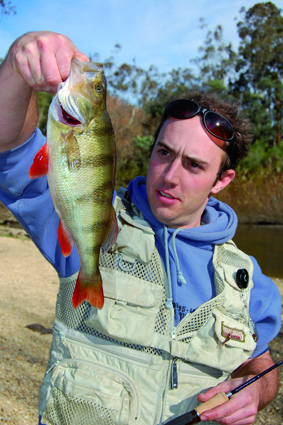
Andy with one of the two ‘keeper’ redfin from our first day. This fish followed our lures a few times before hooking up.

The Rebel Minnow was the most productive of the hard-bodied lures over the weekend.
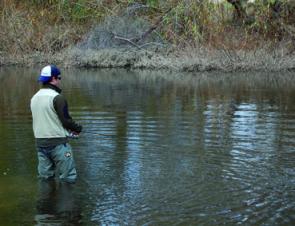
& 12

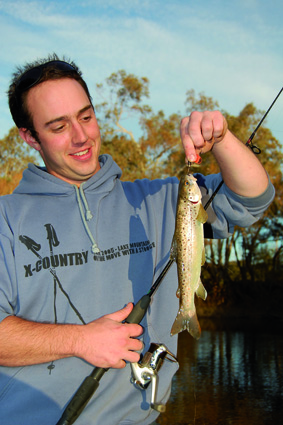
This trout was no record breaker, but it was typical of what we encountered in the mid-section of the Goulburn River over the weekend.
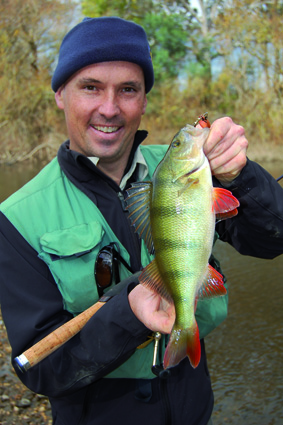
Our second ‘keeper’ redfin from the first day. This fish took the lure within a few winds of the reel handle, having first allowed the Celta to sink deep down the opposite bank.

This finger-long yabby came from inside the best redfin of Day One and helped to explain why our deeper presentations, closer to the riverbed, were more successful on this species.
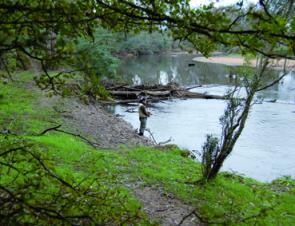
Visibly flowing and broken water was heavily targetted on Day Two. The more we focussed on this kind of water the more trout we encountered.
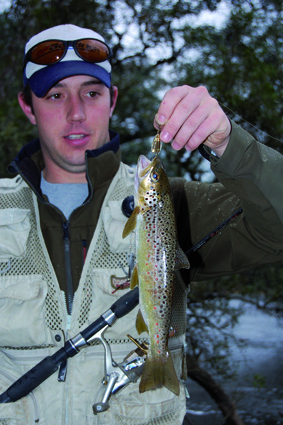
Andy with a brown trout caught on a Celta. These shallow running lures worked well in the moving water because they could be quickly retrieved and kept above the slime-covered river rocks.
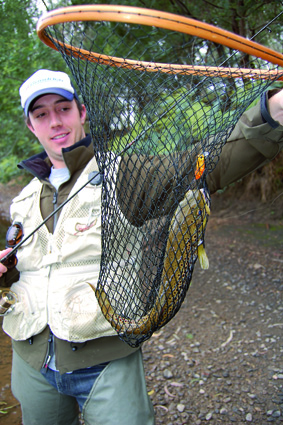
The best trout of our trip was this brown that took a shallow-running Daiwa Cicada hard-bodied lure.
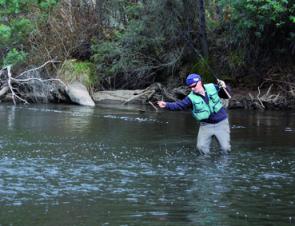
& 9





